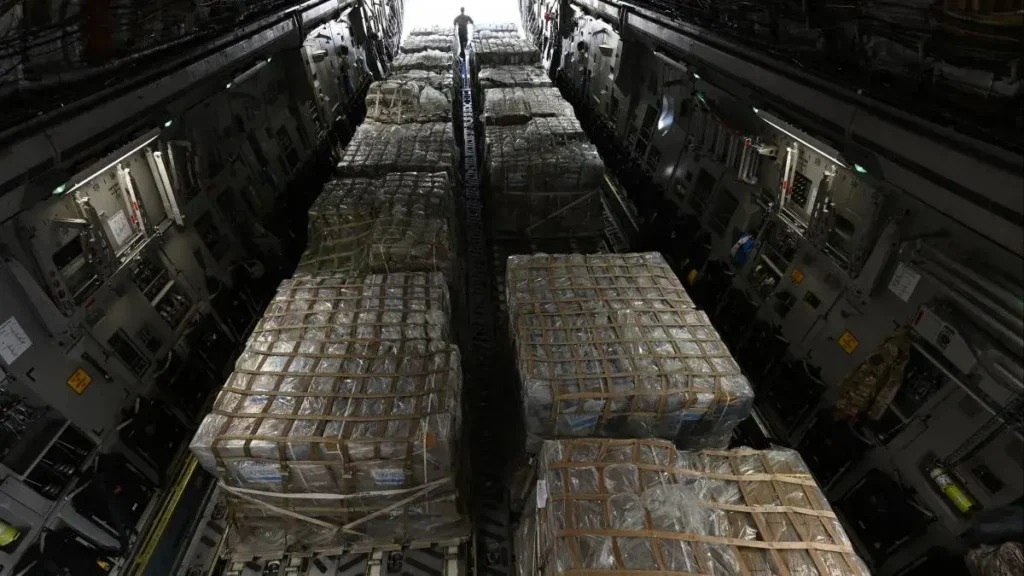As Israel and Hamas continue their war, Gaza faces a humanitarian crisis with severe food shortages and malnutrition.

The northern and central parts of Gaza, where Israel and Hamas have been clashing since Oct. 7, are facing a severe food shortage and a looming famine, according to aid workers and the United Nations. The people there are desperate and hungry, and they scramble for the scarce aid that reaches them. Many of them are visibly starving, with thin bodies and sunken eyes.
The entire Gaza Strip, a small territory where 2.3 million people live, is under the threat of hunger and malnutrition, as Israel’s bombardment has disrupted food supplies and access. The U.N. warned this week that some areas of Gaza could experience famine soon.
The southern part of Gaza, near the border with Egypt, receives some imported food, but not enough to meet the needs of the population. The situation is worse in the north and the centre, where the fighting has been more intense and the aid deliveries more restricted.
“The food situation in the north is absolutely horrific. There’s almost no food available and everybody we talk to begs for food,” said Sean Casey, a World Health Organization (WHO) coordinator in Gaza.
There is no reliable data on the extent of hunger and malnutrition in Gaza, as the aid agencies face difficulties in moving and communicating amid the war. They plan to measure the children’s arms to check for signs of wasting, a serious consequence of malnutrition that can affect physical and mental development.
A report backed by the U.N. in December said that the whole population of Gaza was in a state of hunger crisis and at an increasing risk of famine.
Doctors in Gaza hospitals report seeing babies born ill to undernourished mothers, infants losing weight, mothers unable to breastfeed and wounded patients too weak from hunger to recover from infections.
In a hospital ward in Rafah, a town in southern Gaza, paediatric doctor Jabr al-Shaer showed a baby who had lost 2 kg (4 pounds) in a month and a half, dropping from 7.5 kg to 5.5 kg.
“This is bad. It affects his immunity. He constantly has inflammation in the chest and gastroenteritis,” he said.
The U.N. children’s agency UNICEF estimates that more than 10,000 children in Gaza could suffer from wasting in the next weeks, one of the most severe outcomes of malnutrition, which can impair physical growth and brain development.
Ayadil Saparbekov, a WHO doctor who was recently in northern Gaza, said he had especially seen children and elderly people showing signs of wasting, and described people coming to beg for food, raising hands to mouths to mime eating.
“I saw children on the streets who were visibly malnourished by the look on their faces. They were visibly thin. Their hands were thin and they had sunken eyes,” he said, estimating that two or three of every 10 children he saw there matched that description.
At the beginning of the war, after a Hamas attack that killed more than 1,200 people, Israel said it was stopping all supplies to Gaza. It later agreed to allow humanitarian aid, but much less than what was entering the territory before Oct 7.
Israel’s military operation in Gaza has killed at least 25,700 Palestinians since Oct. 7, according to health authorities in the Hamas-controlled enclave.
Aid agencies say Israeli controls are hindering aid deliveries into Gaza and that the military blocks distribution outside the southern area around Rafah.

Israeli government spokesperson Eylon Levy has denied there are restrictions on humanitarian aid entering Gaza and attributed any problems to U.N. distribution capacity.
However, World Food Programme spokesperson Abeer Etefa said there was a “systematic limitation” on aid reaching the north and the U.N. humanitarian agency OCHA said Israel had only allowed about a quarter of planned aid deliveries there.
According to Juliette Touma, a spokeswoman for UNRWA, the U.N. aid agency for Palestinians, about 200,000 people are still living in the north of Gaza, where food and other supplies are scarce. Verified social media videos by Reuters have captured the scenes of panic and desperation as people scramble for the rare aid deliveries.
Nick Maynard, a British surgeon who worked in a Gaza hospital, recalled a young boy of seven or eight years old who came to him asking for food. “He said all his family had been killed and he hadn’t eaten for three days,” he said.
Even in the south of Gaza, where some food imports are allowed, people are struggling to feed themselves. Some Gaza residents have resorted to grinding animal feed to make dry and hard bread that is barely edible.
Palestinians interviewed by Reuters said they often went without food for days or could only eat once a day. The food that was available in the market was often too expensive for them to afford.
Heather Stobaugh of Action Against Hunger said that the biggest threat in Gaza was severe acute malnutrition, which happens when people do not get the right nutrients for their body to function properly. She said that children were the most vulnerable to dying from this condition.







